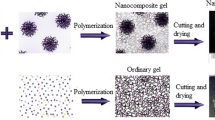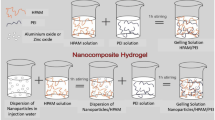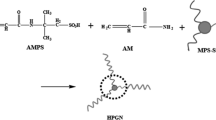Abstract
The present study introduces a new method of preformed particle gel (PPG) synthesizing that leads to manufacturing gel particles containing nanogel particles inside them with optimized properties at high temperature and high salinity. Acrylamide-based nanogels cross-linked with N,N′-methylenebis(acrylamide) were prepared by inverse microemulsion polymerization and using sorbitan monooleate and polyoxyethylene sorbitan monooleate as emulsifiers and cyclohexane as oleic phase. The cross-linker-to-monomer weight ratio, emulsifier composition and oleic phase-to-emulsifier weight ratio were optimized using gel purification tests, conductivity tests and phase separation tests. Image analysis of nanogel particles showed that their shape is spherical with about 86 nm in diameter. In the next step, bulk gel containing nanogel particles was manufactured by bulk polymerization method and nanogel content in bulk gel was optimized. Finally, swelling test of gel particles in brine with the salinity of 180,000 ppm and the temperature of 80 °C for three days showed that the new PPG has higher water absorbance capacity compared to the ordinary PPG. In addition, dynamic swelling of both samples followed Voigt’s equation and showed that the new PPG has higher swelling rate at initial stages than the ordinary PPG. Rheology tests at this condition indicated that the amount of elastic modulus of the new hydrogel is lower than that of the ordinary hydrogel. These properties make the new synthesized gel a good candidate for deep reservoir conformance control at harsh conditions of high salinity and high temperature.











Similar content being viewed by others
Notes
The lithium-air battery is an electrochemical cell in which lithium is oxidized at the anode and oxygen is reduced at the cathode and hence, a current flow is produced [4].
Dye-sensitized solar cells are thin film solar cells, which convert the solar energy to the electricity based on the photo electrochemical processes [9].
Chemical element of Palladium.
Chemical element of Silver.
Preformed particle gel (PPG) is a type of gel in the form of particles, which is produced at the surface prior to injection into the reservoir.
Fourier Transform Infrared (FTIR) is a technique used to obtain the infrared spectrum of absorption or emission of a sample. In this method, a mathematical procedure based on Fourier transform is used to convert the raw data (interferogram) to the actual spectrum, which can be used to determine the functional groups in the sample [51].
FESEM is a microscope in which electrons liberated by a source scan the sample to produce an image of its surface.
References
Najafipour A, Mahdavian AR, Aliabadi HS, Fassihi A (2019) Dual thermo-and pH-responsive poly (N-isopropylacrylamide-co-(2-dimethylamino) ethyl methacrylate)-g-PEG nanoparticle system and its potential in controlled drug release. Polym Bull,1–14
Dharmasiri MB, Mudiyanselage TK (2020) Thermo-responsive poly (N-isopropyl acrylamide) hydrogel with increased response rate. Polym Bull, 1–16
Rueda JC, Suárez C, Komber H, Zschoche S, Voit B (2020) Synthesis and characterization of pH-and thermo-responsive hydrogels based on poly (2-cyclopropyl-2-oxazoline) macromonomer, sodium acrylate, and acrylamide. Polym Bull 77(10):5553–5565
Badwal SP, Giddey SS, Munnings C, Bhatt AI, Hollenkamp AF (2014) Emerging electrochemical energy conversion and storage technologies. Front Chem 2:79
Chen S, Sun P, Sun B, Humphreys J, Zou P, Xie K, Tao S (2021) Nitrate-based ‘oversaturated gel electrolyte’for high-voltage and high-stability aqueous lithium batteries. Energy Mater 37:598–608
Piana G, Ricciardi M, Bella F, Cucciniello R, Proto A, Gerbaldi C (2020) Poly (glycidyl ether) s recycling from industrial waste and feasibility study of reuse as electrolytes in sodium-based batteries. Chem Eng J 382:122934
Fu Y, Lei X, Yin H, Liu X (2021) Rational reconfiguration of a gradient redox mediator with in-situ fabricated gel electrolyte for Li–air batteries. Chem Eng J 416:129016
Galliano S, Bella F, Bonomo M, Giordano F, Grätzel M, Viscardi G, Hagfeldt A, Gerbaldi C, Barolo C (2021) Xanthan‐based hydrogel for stable and efficient quasi‐solid truly aqueous dye‐sensitized solar cell with cobalt mediator. Solar Rrl, 2000823
Sharma K, Sharma V, Sharma S (2018) Dye-sensitized solar cells: fundamentals and current status. Nanoscale Res Lett 13(1):1–46
Fagiolari L, Bonomo M, Cognetti A, Meligrana G, Gerbaldi C, Barolo C, Bella F (2020) Photoanodes for aqueous solar cells exploring additives and formulations starting from a commercial TiO2 paste. Chem Sustain Enery Mater 13(24):6562–6573
Galliano S, Bella F, Bonomo M, Viscardi G, Gerbaldi C, Boschloo G, Barolo C (2020) Hydrogel electrolytes based on xanthan gum: green route towards stable dye-sensitized solar cells. Nanomaterials 10(8):1585
Mir SH, Ochiai B (2017) One-pot fabrication of hollow polymer@ Ag nanospheres for printable translucent conductive coatings. Adv Mater Interfaces 4(14):1601198
Mir SH, Nagahara LA, Thundat T, Mokarian-Tabari P, Furukawa H, Khosla A (2018) Organic-inorganic hybrid functional materials: an integrated platform for applied technologies. J Electrochem Soc 165(8):B3137–B3156
Zielińska A, Carreiró F, Oliveira AM, Neves A, Pires B, Venkatesh DN, Durazzo A, Lucarini M, Eder P, Silva AM (2020) Polymeric nanoparticles: production, characterization, toxicology and ecotoxicology. Molecules 25(16):3731
Mir SH, Ochiai B (2016) Fabrication of polymer-Ag honeycomb hybrid film by metal complexation induced phase separation at the air/water interface. Macromol Mater Eng 301(9):1026–1031
Kumar S, Baruah S, Puzari A (2020) Poly (p-phenylenediamine)-based nanocomposites with metal oxide nanoparticle for optoelectronic and magneto-optic application. Polym Bull 77(1):441–457
Mir SH, Ochiai B (2018) Conductive polymer-Ag honeycomb thin film: the factors affecting the complexity of the microstructure. J Electrochem Soc 165(8):B3030–B3034
Gai H, Wu Y, Wang Z, Wu L, Shi Y, Jing M, Zou K (2008) Polymer-assisted solvothermal growth of CdS nanowires. Polym Bull 61(4):435–441
Mir SH, Hasan P, Danish EY, Aslam M (2020) Pd-induced phase separation in poly (methyl methacrylate) telopolymer: synthesis of nanostructured catalytic Pd nanorods. Colloid Polym Sci 298:441–448
Mir SH, Ochiai B (2016) Development of hierarchical polymer@ Pd nanowire-network: synthesis and application as highly active recyclable catalyst and printable conductive ink. ChemistryOpen 5(3):213–218
Li Z (2007) Technical and economic potential for polymer flooding in Shengli Oilfield. Pet Explor Dev 34(1):79–82
Zhang P, Huang W, Jia Z, Zhou C, Guo M, Wang Y (2014) Conformation and adsorption behavior of associative polymer for enhanced oil recovery using single molecule force spectroscopy. J Polym Res 21(8):523
Derikvand Z, Riazi M (2016) Experimental investigation of a novel foam formulation to improve foam quality. J Mol Liq 224:1311–1318
Zhang Y, Yue X, Dong J, Yu L (2000) New and effective foam flooding to recover oil in heterogeneous reservoir. In: SPE/DOE improved oil recovery symposium. Society of Petroleum Engineers
Ganguly S (2011) Effect of pressure gradient on the flow of oil and water in gel-filled pore. Chem Eng Res Des 89(11):2380–2388
Hatzignatiou DG, Giske NH (2018) Sodium silicate gelants for water management in naturally fractured hydrocarbon carbonate formations. Chem Eng Res Des 132:40–56
Vargo J, Turner J, Vergnani B, Pitts MJ, Wyatt K, Surkalo H, Patterson D (1999) Alkaline-surfactant-polymer flooding of the Cambridge Minnelusa field. In: SPE Rocky Mountain Regional Meeting. Society of Petroleum Engineers
Bai B, Li Y, Liu X (1999) New development of water shutoff and profile control in oilfields in China. Oil Drill Prod Technol 20(3):64–68
Wang H, Guo W, Jiang H (2001) Study and application of weak gel system prepared by complex polymer used for depth profile modification. In: SPE International Symposium on Oilfield Chemistry. Society of Petroleum Engineers
Goudarzi A, Zhang H, Varavei A, Taksaudom P, Hu Y, Delshad M, Bai B, Sepehrnoori K (2015) A laboratory and simulation study of preformed particle gels for water conformance control. Fuel 140:502–513
Alhuraishawy AK, Sun X, Bai B, Wei M, Imqam A (2018) Areal sweep efficiency improvement by integrating preformed particle gel and low salinity water flooding in fractured reservoirs. Fuel 221:380–392
Wang Z, Bai B, Sun X, Wang J (2019) Effect of multiple factors on preformed particle gel placement, dehydration, and plugging performance in partially open fractures. Fuel 251:73–81
Zhang L, Khan N, Pu C (2019) A new method of plugging the fracture to enhance oil production for fractured oil reservoir using gel particles and the HPAM/Cr3+ system. Polymers 11(3):446
Zhu D, Bai B, Hou J (2017) Polymer gel systems for water management in high-temperature petroleum reservoirs: a chemical review. Energy Fuels 31(12):13063–13087
Wang C, Zhong L, Liu Y, Han Y, Zhao P, Yuan Y, Han X (2020) Characteristics of weak-gel flooding and its application in LD10-1 oilfield. ACS Omega 5(38):24935–24945
Hou G, Zhao W, Jia Y, Yuan X, Zhou J, Liu T, Hou J (2020) Field Application of nanoscale polymer microspheres for in-depth profile control in the ultralow permeability oil reservoir. Front Chem 8:805
Liu Y, Li Y, Zhang Y, Li H, Xue B, Wang N, Lu X, Dai L, Xia H, Xie K (2019) Water-alternating-weak gel technology and its application in high water cut oil reservoir in Bohai Oilfield. In: SPE middle east oil and gas show and conference. Society of Petroleum Engineers
Zareie C, Bahramian AR, Sefti MV, Salehi MB (2019) Network-gel strength relationship and performance improvement of polyacrylamide hydrogel using nano-silica; with regards to application in oil wells conditions. J Mol Liq 278:512–520
Sun F, Lin M, Dong Z, Zhang G (2019) Delayed-crosslink hydrogel for improving oil recovery in differential heterogeneous reservoirs. ACS Omega 5(1):228–235
Bai B, Li L, Liu Y, Liu H, Wang Z, You C (2007) Preformed particle gel for conformance control: factors affecting its properties and applications. SPE Reservoir Eval Eng 10(04):415–422
Lei G, Li L, Nasr-El-Din HA (2011) New gel aggregates to improve sweep efficiency during waterflooding. SPE Reservoir Eval Eng 14(01):120–128
Imqam A, Bai B, Al Ramadan M, Wei M, Delshad M, Sepehrnoori K (2015) Preformed-particle-gel extrusion through open conduits during conformance-control treatments. SPE J 20(05):1083–1093
Helvacıoğlu E, Aydın V, Nugay T, Nugay N, Uluocak BG, Şen S (2011) High strength poly (acrylamide)-clay hydrogels. J Polym Res 18(6):2341–2350
Farasat A, Sefti MV, Sadeghnejad S, Saghafi HR (2017) Mechanical entrapment analysis of enhanced preformed particle gels (PPGs) in mature reservoirs. J Petrol Sci Eng 157:441–450
Tongwa P, Bai B (2014) Degradable nanocomposite preformed particle gel for chemical enhanced oil recovery applications. J Petrol Sci Eng 124:35–45
Bai B, Zhou J, Liu Y, Tongwa P (2013) Thermo-dissoluble polymer for in-depth mobility control. In: IPTC 2013: International Petroleum Technology Conference. European Association of Geoscientists & Engineers, pp cp-350–00424
Pu J, Bai B, Alhuraishawy A, Schuman T, Chen Y, Sun X (2018) A novel re-crosslinkable preformed particle gel for conformance control in extreme heterogeneous reservoirs. In: SPE annual technical conference and exhibition. Society of Petroleum Engineers
Pu J, Bai B, Alhuraishawy A, Schuman T, Chen Y, Sun X (2019) A Recrosslinkable preformed particle gel for conformance control in heterogeneous reservoirs containing linear-flow features. SPE J 24(04):1714–1725
Hwu H-D, Lee Y-D (2002) Monomer effects on emulsion polymerization with ASR as the surfactant. J Polym Res 9(3):183–188
Aiqin Z, Yinghua S, Xiangying Z, Lingcui H, Zhizhong W (2010) A comparison of composition and sequence distribution of p (AM-MADQUAT) prepared by solution and inverse microemulsion polymerization. J Polym Res 17(1):11
Shameer PM, Nishath PM (2019) Exploration and enhancement on fuel stability of biodiesel: A step forward in the track of global commercialization. In: Advanced Biofuels. Elsevier, pp 181–213
Lenji MA, Haghshenasfard M, Sefti MV, Salehi MB (2018) Experimental study of swelling and rheological behavior of preformed particle gel used in water shutoff treatment. J Petrol Sci Eng 169:739–747
Bumajdad A, Eastoe J (2004) Conductivity of mixed surfactant water-in-oil microemulsions. Phys Chem Chem Phys 6(7):1597–1602
Karunaratne DN, Pamunuwa G, Ranatunga U (2017) Introductory chapter: Microemulsions. In: Properties and uses of microemulsions. IntechOpen
Liu D, Ma J, Cheng H, Zhao Z (1998) Investigation on the conductivity and microstructure of AOT/non-ionic surfactants/water/n-heptane mixed reverse micelles. Colloids Surf A 135(1–3):157–164
Liu D, Ma J, Cheng H, Zhao Z (1999) Conducting properties of mixed reverse micelles. Colloids Surf A 148(3):291–298
Wang L, Zhang G, Ge J-J, Li G, Zhang J, Ding B (2010) Preparation of microgel nanospheres and their application in EOR. In: International Oil and Gas Conference and Exhibition in China. Society of Petroleum Engineers
Pathak M (2017) Nanoemulsions and their stability for enhancing functional properties of food ingredients. In: Nanotechnology applications in food. Elsevier, pp 87–106
Pavia DL, Lampman GM, Kriz GS (2001) Introduction to spectroscopy a guide for student of organic chemistry. Brooks/Cole, London
Yao C, Xu X, Wang D, Lei G, Xue S, Hou J, Cathles LM, Steenhuis TS (2016) Research and application of micron-size polyacrylamide elastic microspheres as a smart sweep improvement and profile modification agent. In: SPE Improved Oil Recovery Conference. Society of Petroleum Engineers
Omidian H, Hashemi S, Sammes P, Meldrum I (1998) A model for the swelling of superabsorbent polymers. Polymer 39(26):6697–6704
Lashari ZA, Yang H, Zhu Z, Tang X, Cao C, Iqbal MW, Kang W (2018) Experimental research of high strength thermally stable organic composite polymer gel. J Mol Liq 263:118–124
Hasankhani GM, Madani M, Esmaeilzadeh F, Mowla D (2019) Experimental investigation of asphaltene-augmented gel polymer performance for water shut-off and enhancing oil recovery in fractured oil reservoirs. J Mol Liq 275:654–666
Sydansk R, Al-Dhafeeri A, Xiong Y, Seright RS (2004) Polymer gels formulated with a combination of high and low molecular-weight polymers provide improved performance for water-shutoff treatments of fractured production Wells. In: SPE/DOE Symposium on Improved Oil Recovery. Society of Petroleum Engineers
Sydansk R, Xiong Y, Al-Dhafeeri A, Schrader R, Seright R (2004) Characterization of partially formed polymer gels for application to fractured production wells for water-shutoff purposes. In: SPE/DOE Symposium on Improved Oil Recovery. Society of Petroleum Engineers
Pu J, Geng J, Han P, Bai B (2019) Preparation and salt-insensitive behavior study of swellable, Cr3+-embedded microgels for water management. J Mol Liq 273:551–558
Hamzah YB, Hashim S, Abd Rahman WAW (2017) Synthesis of polymeric nano/microgels: a review. J Polym Res 24(9):134
Mohammadi MS, Sahraei E, Bayati B (2020) Synthesis optimization and characterization of high molecular weight polymeric nanoparticles as EOR agent for harsh condition reservoirs. J Polym Res 27(2):41
Al-Anazi HA, Sharma MM (2002) Use of a pH sensitive polymer for conformance control. In: International Symposium and Exhibition on Formation Damage Control. Society of Petroleum Engineers
Huh C, Choi SK, Sharma MM (2005) A rheological model for pH-sensitive ionic polymer solutions for optimal mobility control applications. In: SPE annual technical conference and exhibition. Society of Petroleum Engineers
Tally M, Atassi Y (2015) Optimized synthesis and swelling properties of a pH-sensitive semi-IPN superabsorbent polymer based on sodium alginate-g-poly (acrylic acid-co-acrylamide) and polyvinylpyrrolidone and obtained via microwave irradiation. J Polym Res 22(9):181
Cheung S, Ng R, Frampton H, Chang K, Morgan J (2007) A swelling polymer for in-depth profile modification: update on field applications. In: SPE Applied Technology Workshop of “Chemical Methods of Reducing Water Production,” San Antonia, Texas, USA. pp 4–6
Vasquez JE, Dalrymple ED, Abbasy I, Eoff LS (2008) Laboratory evaluation of water swellable materials for fracture shutoff. In: SPE North Africa Technical Conference and Exhibition. Society of Petroleum Engineers
Li W, Wang J, Zou L, Zhu S (2008) Synthesis and characterization of potassium humate–acrylic acid–acrylamide hydrogel. J Polym Res 15(6):435–445
Frampton H, Morgan J, Cheung S, Munson L, Chang K, Williams D (2004) Development of a novel waterflood conformance control system. In: SPE/DOE Symposium on Improved Oil Recovery. Society of Petroleum Engineers
Pritchett J, Frampton H, Brinkman J, Cheung S, Morgan J, Chang K, Williams D, Goodgame J (2003) Field application of a new in-depth waterflood conformance improvement tool. In: SPE international improved oil recovery conference in Asia Pacific. Society of Petroleum Engineers
Funding
This research did not receive any specific grant from funding agencies in the public, commercial or not-for-profit sectors.
Author information
Authors and Affiliations
Corresponding author
Additional information
Publisher's Note
Springer Nature remains neutral with regard to jurisdictional claims in published maps and institutional affiliations.
Rights and permissions
About this article
Cite this article
Seidy Esfahlan, M., Khodapanah, E., Tabatabaei-Nezhad, S.A. et al. Fabrication, optimization and characterization of preformed-particle-gel containing nanogel particles for conformance control in oil reservoirs. Polym. Bull. 79, 7137–7159 (2022). https://doi.org/10.1007/s00289-021-03843-2
Received:
Revised:
Accepted:
Published:
Issue Date:
DOI: https://doi.org/10.1007/s00289-021-03843-2




